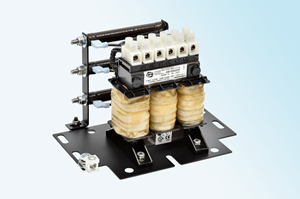What Output Problems Can Occur with Variable Frequency Drives (VFD or VSD) and How Can You Mitigate These Issues?
A voltage-sourced Variable Frequency Drive (VFD) uses Insulated-Gate Bipolar Transistors (IGBTs) to rapidly switch voltage on and off to form a Pulse Width Modulated (PWM) voltage source for the motor. The PWM simulates a sine wave voltage source to the motor and it operates as if it was being powered by a sine wave. The PWM wave allows the VFD to change the fundamental frequency of the PWM waveform and simulate sine waves. Since the speed of a motor is directly related to the fundamental frequency of the sine wave, a VFD can control speeds from a fraction of a hertz to hundreds of hertz.
Output reactors, dV/dT filters or drive isolation transformers can be used to help mitigate some issues caused by the PWM output. A VFD’s PWM output causes rapid switching transitions which can cause over-voltages due to parasitic capacitance and inductance in the motor’s leads. The parasitic currents and voltages can be determined by the equation of V = L × (Δi/Δt). VFD switching frequencies (the amount of pulses used to simulate the sine wave) generally range from 1,000-10,000 pulses per second. IGBT’s produce an almost perfect square wave which produces a very high Δv/Δt. High Δv/Δt can cause higher surge currents in the leads. This then causes high voltage pulses across the parasitic inductances. Therefore, the faster the pulses switch, the greater the impact of cable capacitance and inductance. These voltage pulses stress the motor’s windings causing higher audible noise, heat and possibly premature failure of the insulation. There is also capacitance in the motor’s bearings. The combination of lubrication and air gaps prevent direct and continuous contact of the bearings to the metal traces that contain them. Parasitic currents [I = C × (Δv/Δt)] cause current to flow through the bearings. The amount of current will increase as the VFD output switching speed increases. These currents can cause micro pits to form in the bearings and eventually will lead to premature bearing failure.

